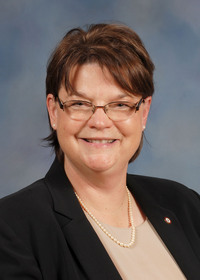Information Possibly Outdated
The information presented on this page was originally released on December 9, 2002. It may not be outdated, but please search our site for more current information. If you plan to quote or reference this information in a publication, please check with the Extension specialist or author before proceeding.
Plan fun, stress-free holiday social events
MISSISSIPPI STATE -- The holidays tend to turn ordinary people into party-hosts, but without proper planning, the task can be overwhelming.
Typical goals of parties are a beautiful setting, pretty and delicious food, and a good time for everyone, the host and hostess included.
Rebecca Kelly, human nutrition specialist and a registered dietitian with Mississippi State University's Extension Service, said entertaining for the holidays can be as simple or complex as people want to make it.
"Planning is the key to having a successful party. Planning helps make the party foods easy to make, beautiful to look at and delicious to eat," Kelly said.
She recommended party planners start with a time line several weeks before the event. Decide when to mail invitations and to finalize the menu. The time line should determine when ingredients need to be bought, serving or cooking items gathered or rented, and arrangements made with the caterer or bakery.
"In planning the menu, think about balance," Kelly said. "Balance sweet foods with salty ones, rich foods with simple items, crunchy with smooth or creamy, hot with cold, and spicy foods with less flavorful ones."
Use colors to create an interesting and appetizing table. Serving different colored foods also offers a variety of textures and nutrients to guests.
Kelly advised planning a menu that allows some food to be made in advance and stored safely. Take advantage of catering and bakery services to ease the load of preparation.
"It's been said many times before, but it really is best to serve food that you have made at least one time," Kelly said. "Knowing how good something will taste and how easy or hard it is to make will help you decide if you want to serve it at your next party."
Keep in mind guests' dietary needs and preferences when planning the menu, but realize that this is a party, not a dining service. Include some fresh fruits and fresh or roasted vegetables to meet the dietary requirements of a variety of people.
"Offer foods that accommodate your guests as best you can," Kelly said. "If you are serving foods that contain nuts or seafood, especially if these are prepared so the items are hard to see, be sure your guests know which foods contain these ingredients."
After the menu is planned, it's time to decide how much food is needed, which depends on the number of guests expected.
"A general guideline when planning special events is to serve 20 percent more food for 20 guests, 15 percent more for 50 guests, 10 percent for 100 guests, and 5 to 10 percent more for 100 or more guests," Kelly said. "To be on the safe side, I look at the number of servings a recipe will make and plan for 1 servings per guest.
"It is better to have a little too much food than not enough," she said.
To calculate the number of guests who can be accommodated, divide by 10 the square feet of the room in which guests will be seated. Be sure to subtract from the room's measurement the space needed for the buffet table.
A buffet table that serves on one side requires five feet of space in addition to the width of the table. One where guests serve from both sides requires 10 feet plus the width of the table.
One way to avoid the hassle of cooking, serving, keeping items hot and cold, and replenishing is to have the event catered. Kelly suggested party hosts consider hiring a caterer if more than 25 guests are expected, cooking facilities are limited, the party location is at a public facility or out of town, or the host or hostess is unable to cook or simply doesn't like to cook.
Alcohol is often served at holiday gatherings, but Kelly said this decision is up to the host. She said food, not alcohol, should be the center of attention, and any beverage served should complement, not overpower, the food. If alcohol is available, offer non-alcoholic drinks as well and be prepared to accommodate guests who may drink too much.
"Remember that the purpose of the party is for everyone, yourself included, to have a good time," Kelly said. "Reflect afterwards on the event and how well you and your guests enjoyed it, what foods were eaten the most, what hassles were encountered and whether you were worn out."
Kelly suggested writing things such as the guest list, menu and notes about the event on the back of the invitation. File this away for future reference when planning another social event.
Contact: Dr. Rebecca Kelly, (662) 325-1801






